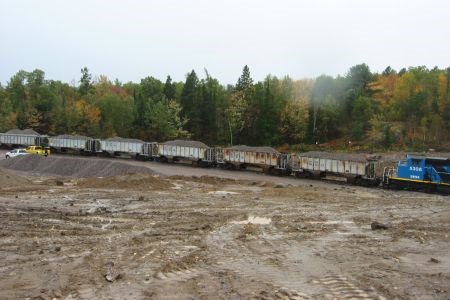Serpent River First Nation is laying the groundwork to become a northeastern Ontario transportation hub.
The First Nation community partnered with Sudbury's Mansour Group to land a railway ballast contract last summer to supply 125,000 tonnes of rock for the Huron Central Railway's $33-million track reconstruction project.
Under the banner of M'Anishnabek Industries, Serpent River and Mansour quickly built a 1,000-foot long railroad siding in an amazing six weeks, extending from the Huron Central line into a once-abandoned quarry where rail cars are loaded with crushed rock to be used as track bedding for the short-line railroad.
“This thing has moved at lightning speed,” said Serpent River Chief Isadore Day.
The first ballast train rolled up to the quarry in late September as track repairs began this fall on the Sault Ste. Marie-to-Sudbury line. Mansour supplied the locomotive and rolling stock.
The siding can accommodate 17, 70-foot long ballast cars, each capable of carrying 100 tonnes.
The quarry, which belongs to the First Nation, was once used to supply aggregate for the Highway 17 rehabilitation in 2004. It's located only a few hundred metres between the highway and the railway, and is accessible by a side road.
Serpent River has been vocal for years in wanting to be consulted and allowed to participate in area resource and infrastructure development within its traditional territory.
But both Day and project manager Brian Rogers said the Huron Central contract wasn't just handed to them.
The First Nation and its industry partner grabbed the lion's share of the larger 160,000-tonne contract because Rogers came up with the idea of a ballast train.
There were a number of locations along the line where the rail carrier wanted to stockpile material. But in Serpent River's proposal, they indicated rail cars could be hauled into the quarry for loading and delivered to a section of track rather than using dump trucks.
The First Nation and BM Metals Services, a Mansour subsidiary, built the $500,000 siding with some assistance on the rail material provided by the Huron Central.
The biggest chore was months of planning to blast out a rock cut for the siding.
Day said the proposal was an “essential piece” in being successful in the tendering process.
The operation has created between 14 -16 jobs, but Serpent River would like to keep the momentum going beyond the life of the contract.
“We're very fortunate to have access to their contract because it gets us set up,” said Day. “It gets the infrastructure in place and we've got some business development decisions to make in the near future.”
Rogers said the quarry rock is diabase which is ideal highway grade material, particularly for Superpave projects.
“Once we satisfy the Huron Central requirements, the plan is to work with our crusher to produce 1,000 tonnes for testing by the Ministry of Transportation.”
Rogers said there is the potential of other quarry pits in the area with an estimated 94-million tonnes of material that could be mined and sold as aggregate.
Having a permanent track in place also opens the door for other possibilities such as a rail-to-truck reload facility to handle other bulk freight.
Day said the First Nation is even considering a deep water port on the North Channel of Lake Huron.
The natural harbour at Cutler was historically used in the early 20th century by lumber ships and by other commercial vessels years later. Day said the outline of a pier still remains.
Some aggregate and mineral companies have encouraged the First Nation to build port facilities. “There's definitely active interest,” said Rogers.
“It's something that we've talked about in recent months,” said Day. “If industry calls for a diverse transportation network, Serpent River's going to be an opportunity for that to happen.”
The entrepreneurial-minded community of 700 is very active on the economic development front with a gas bar, restaurant, general store, art gallery, commercial office space and big plans to break into the energy industry.
Another major development in the works is a light industrial park with a factory that produces LED light bulbs through a partnership with Glo North Energy Solutions.
Once government funds are in place, construction of a $3.9-million, 50,000-square-foot plant will begin next fall with the assembly line starting up the following spring. The operation will employ 21 at the start and max out at 54 jobs by the fifth year.
If their business aspirations continue to grow, Day said it's important that all their residents, both on and off reserve, be consulted and approve of any development through referendum.
The band's guiding principle in sustainable economic development is a triple bottom line accounting approach in measuring performance through respect for people, the environment and economic return.




